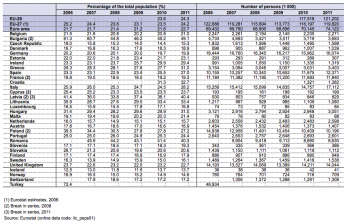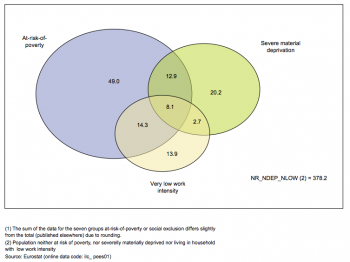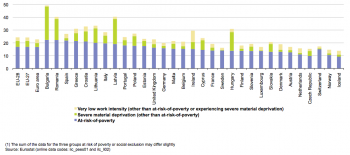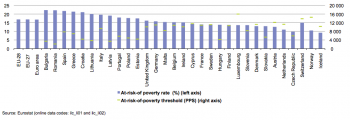Archive:Social inclusion statistics
Data from March 2013. Most recent data: Further Eurostat information, Main tables and Database.


(million) - Source: Eurostat (ilc_pees01)

(%) - Source: Eurostat (ilc_pees01) and (ilc_li02)

(%) - Source: Eurostat (ilc_sip8)

(%) - Source: Eurostat (ilc_lvhl11)
Social inclusion has long been a key part of the European Union‘s (EU) policies. The overriding goal of EU policy in this area is to reduce substantially the number of people at-risk-of-poverty or social exclusion, thereby creating a more inclusive society.
However, as multi-dimensional concepts, poverty and social exclusion cannot easily be measured through statistics. As a result, both monetary and non-monetary indicators have been developed, such as the at-risk-of-poverty rate, the at-risk-of-poverty threshold, the severe material deprivation rate and the share of people living in households with very low work intensity. There are a range of other indicators that are equally relevant when analysing social inclusion, for example: access to education and training, health, or housing.
Main statistical findings
At-risk-of-poverty or social exclusion
The situation in 2011
In 2011 there were 119.568 million people in the EU-27, equivalent to 24.2 % of the entire population, who lived in households facing poverty or social exclusion (see Table 1). Although the number of people at-risk-of poverty or social exclusion declined during the period from 2006 to 2009, this trend was reversed in 2010, as the proportion rose by 0.5 percentage points (equivalent to 2.5 million people) when compared with 2009. In 2011 that proportion increased by a further 0.6 percentage points (equivalent to 3.2 million people) compared to 2010. This indicator for the EU-27, calculated as a weighted average of the national results, conceals considerable variations between EU Member States. In Bulgaria (49.1 %) half of the population was considered to be at risk of poverty or social exclusion in 2011, while in Latvia (40.4 %) and Romania (40.3 %) the proportion accounts for approximately two fifths of the population. In Lithuania (33.4 %) the proportion exceeded a third of the population.
More than a quarter of the population was considered to be at-risk-of-poverty or social exclusion in five other Member States in 2011, namely Greece and Hungary (both 31.0 %), Italy (28.2 %), Poland (27.2 %) and Spain (27.0 %). Croatia also reported a relatively high at-risk-of-poverty or social exclusion rate, at close to one third of the population (32.7 %). Those EU Member States with the lowest proportions of the population considered to be at-risk-of-poverty or social exclusion in 2011 were the Czech Republic (15.3 %), the Netherlands (15.7 %) and Sweden (16.1 %); Iceland (13.7 %) and Norway (14.6 %) also reported a relatively low share of their respective population as being at-risk-of-poverty or social exclusion.
In 2011, there were 17.1 million persons at-risk-of-poverty or social exclusion in Italy and another 16.1 million persons in Germany, which were the highest numbers in the EU-27 and equivalent to more than a quarter of the EU-27 total. There were between 10 and 15 million persons at-risk-of-poverty or social exclusion in the United Kingdom, Spain, France and Poland in 2011.
The latest developments between 2010 and 2011 show that the proportion of the population at-risk-of-poverty or social exclusion fell in Romania, Portugal, Poland, the United Kingdom, Luxembourg and Bulgaria, while in Slovakia and Lithuania shares remained stable. All of the remaining EU Member States reported an increase in the proportion of persons at-risk-of-poverty or social exclusion during 2011.. By far the largest increases occurred in Italy (up 3.7 percentage points) and Greece (up 3.3 percentage points), followed by Latvia (up 2.3 percentage points) and Spain (up 1.5 percentage points).
In absolute terms, the figures for Italy, Spain and Greece had the greatest upward impact on the number of persons considered to be at-risk-of-poverty or social exclusion in the EU-27 in 2011. These Member States reported increases of 2.3 million, 696 000 and 372 000 people respectively in terms of the number of people at-risk-of poverty or social exclusion between 2010 and 2011.
Medium term developments
Looking further back, at all of the years presented in Table 1, the proportion of the EU-27 population that was at-risk-of-poverty or social exclusion fell from 25.2 % in 2006 to 23.1 % in 2009, before rising again (as noted above) to 23.6 % in 2010 and 24.2 % in 2011. More than half of the EU Member States displayed a similar development: with a relatively high proportion of the population at-risk-of-poverty or social exclusion in 2006 or 2007; the lowest proportion recorded in 2008 or 2009; and a rising share in 2010 and/or 2011.
The main exceptions to this general pattern were Poland and Romania where the proportion of persons at-risk-of-poverty and social exclusion fell throughout the period under consideration, as well as Luxembourg (apart from an increase in 2009). Malta displayed the opposite development to that for Poland and Romania, namely the proportion of persons at-risk-of-poverty and social exclusion increased each year. Developments in Portugal and Slovenia were slightly different from the general pattern, insofar as the proportion of persons at-risk-of-poverty or social exclusion increased through until 2008, but thereafter the pattern was similar to that of many other Member States, with a fall in 2009, before increasing again. The situation in Ireland and Sweden was also a slight variant on the general development, as the lowest proportion was reached relatively early, namely in 2007, after which the proportion of persons at-risk-of-poverty or social exclusion increased (apart from 2010 in Sweden); the reverse was true in Germany, where the lowest proportion was reached relatively late, namely in 2010, before an increase was observed for 2011. Apart from the increase in 2011, developments in Estonia were not similar to those in any other Member State: the highest proportion of persons at-risk-of-poverty or social exclusion was reached in 2009 (when around one third of the Member States were recording their lowest proportions), and a fall was recorded in 2010 when the majority recorded an increase.
Despite a recent increase in the proportion of the population at-risk-of-poverty or social exclusion, the values recorded in 2011 values (2010 for Ireland) were lower than the values recorded in 2006 (2007 for Romania) in 16 Member States, with the largest overall falls recorded for Poland and Bulgaria (where the rate was reduced by more than 12 percentage points), followed by Slovakia and Romania (down by at least 5 percentage points). The largest overall increases were recorded in Ireland (up 6.6 percentage pointsand Spain (up 3.7 percentage points).
Analysis by type of risk
The overall risk of facing poverty or social exclusion is made up of three types of risk: being at-risk-of poverty; facing severe material deprivation; and/or living in a household with very low work intensity – see Figure 1. People are considered to be at-risk-of-poverty or social exclusion if they face at least one of these risks – although 30 % of those people at-risk-of-poverty or social exclusion within the EU-27 faced a combination of two or even all three of these risks. In 2011, there were 48.7 million people in the EU-27 living in households that faced income poverty (but neither severe material deprivation, nor very low work intensity), 20 million persons experiencing severe material deprivation (but neither of the other two risks) and 13.4 million people living in households with very low work intensity (but facing neither of the other two risks). An additional 29.5 million people lived in households facing two out of three of these risks, while a further 8 million people lived in households where all three of these risks were present.
Figure 2 provides a simplified analysis for each EU Member State regarding the proportion of the population facing the three risks identified above, showing:
- the proportion of people at-risk-of-poverty including those living in households that were exclusively at-risk-of-poverty as well as those at-risk-of-poverty combined with either or both of the other two risks; in the EU-27 this amounted to a total of 83.5 million people in 2011;
- the analysis then shows the additional proportion of the population experiencing severe material deprivation (either as a single risk or combined with living in a household with very low work intensity); in the EU-27 this amounted to a total of 22.6 million people in 2011;
- the final category shows the proportion of the population living in households that were exclusively characterised as having a very low work intensity (those that are not at-risk-of-poverty, nor experiencing severe material deprivation); in the EU-27 this amounted to a total of 13.4 million people in 2011.
As such, when summing up the three categories shown in Figure 2, the result corresponds to the overall proportion of the population at-risk-of-poverty or social exclusion (with a possible small deviation due to rounding errors).
At-risk-of-poverty
In 2011, 16.9 % of the EU-27 population was assessed to be at-risk-of-poverty (the monetary dimension of the at-risk-of poverty or social exclusion indicator), with this share ranging from 9.8 % in the Czech Republic to 22.3 % in Bulgaria. Figure 3 also presents an analysis of the at-risk-of poverty threshold, which is defined as 60 % of median income in each of the EU Member States – data are adjusted for price differences between countries. At-risk-of-poverty thresholds for 2011 ranged from a high of PPS 16 000 in Luxembourg down to less than PPS 4 000 in Romania, Latvia, Bulgaria and Lithuania. Social protection systems impact upon the share of the population that is considered to be at-risk-of-poverty. More information on income and poverty is available in an article on income distribution.
Material deprivation and severe material deprivation
Alongside income-related measures of poverty, a broader perspective of social inclusion can be obtained by studying other measures, for example, those relating to material deprivation. An analysis of material deprivation provides a more absolute rather than a relative analysis, as used for income poverty. The definition of material deprivation is based on the inability to afford a selection of items that are considered to be necessary or desirable, namely: having arrears on mortgage or rent payments, utility bills, hire purchase instalments or other loan payments; not being able to afford one week’s annual holiday away from home; not being able to afford a meal with meat, chicken, fish (or vegetarian equivalent) every second day; not being able to face unexpected financial expenses; not being able to buy a telephone (including mobile phone); not being able to buy a colour television; not being able to buy a washing machine; not being able to buy a car; or not being able to afford heating to keep the house warm. The material deprivation rate is defined as the proportion of persons who cannot afford to pay for at least three out of the nine items specified above, while those who are unable to afford four or more items are considered to be severely materially deprived. About one in every six (18.2 %) members of the EU-27 population was materially deprived in 2011, with just under half of these (8.8 % of the total population) being considered as experiencing severe material deprivation. The proportion of people that were materially deprived was highest in Bulgaria (60.1 %), Latvia (49.2 %) and Romania (47.7 %) among the EU Member States, with more than half of the materially deprived in each of these countries experiencing severe material deprivation. Similarly, in Hungary, Lithuania and Greece (which reported the next three highest material deprivation rates) more than half of those considered as materially-deprived experienced severe material deprivation. Less than one in ten people in Luxembourg, the Netherlands and the Nordic Member States were materially deprived and in these Member States less than 3.5 % of the entire population was considered to be severely materially deprived (see Figure 4).
Work intensity
Being in employment is generally an effective way to insulate oneself from the risk of poverty. The indicator covering people living in households with a very low work intensity is defined as those people aged less than 60 who are living in households where the adults worked less than 20 % of their total work potential during the year prior to the survey; these people are more likely to be exposed to social exclusion. In 2011, one tenth of the EU-27’s population aged less than 60 lived in households with very low work intensity, which is stabilized when compared with 2010. In 2011 the proportion of people below the age of 60 living in households with very low work intensity was over 12 % in Belgium, Latvia, Lithuania, Spain and Hungary. That proportion was also relatively high in Croatia (17 %). The fastest expansion in the proportion of persons aged less than 60 living in households with very low work intensity between 2010 and 2011 was reported in Greece (up 4.3 percentage points), , followed by Lithuania and Bulgaria (both up 3.1 percentage points) and Spain (2.4 percentage points). Among the EU Member States, those countries that reported in 2011 the lowest proportions of people living in households with very low work intensity included Cyprus (4.6 %) and Luxembourg (5.8 %); Switzerland recorded an even lower rate (4.7 %).
Data sources and availability
EU statistics on income and living conditions (EU-SILC) are the source of information for statistics relating to income, living conditions and social inclusion. More information on EU-SILC, the calculation of household disposable income, as well as the calculation of household size using the number of ‘equivalent adults’, is provided in an article on income distribution.
Context
At the Laeken European Council in December 2001, European heads of state and government endorsed a first set of common statistical indicators relating to social exclusion and poverty that were subject to a continuing process of refinement by an indicators sub-group that is part of the social protection committee. These indicators are an essential element in the open method of coordination to monitor the progress of EU Member States in the fight against poverty and social exclusion. In May 2006, the social protection committee adopted a portfolio of overarching indicators complemented by specific indicators on social inclusion, pensions and health.
‘The European platform against poverty and social exclusion: a European framework for social and territorial cohesion’ (COM(2010) 758 final) is one of the seven flagship initiatives of the Europe 2020 strategy for smart, sustainable and inclusive growth adopted in 2010. The goals are to:
- ensure economic, social and territorial cohesion;
- guarantee respect for the fundamental rights of people experiencing poverty and social exclusion, and enable them to live in dignity and take an active part in society;
- mobilise support to help people integrate in the communities where they live, get training and help them to find a job and have access to social benefits.
In the context of the Europe 2020 strategy, the European Council adopted in June 2010 a headline target on social inclusion. EU-SILC is the source for this indicator concerning people at-risk-of-poverty or social exclusion which combines three sub-indicators: the at-risk-of-poverty rate, severe material deprivation rate and people living in households with very low work intensity. One of the headline targets set to measure progress in meeting the goals of the Europe 2020 strategy is for the EU-27 as a whole to have at least 20 million fewer people at-risk-of poverty or social exclusion by 2020.
One leading initiative, in respect to the Europe 2020 headline target, has been a Communication of the European Commission relating to a series of ‘national Roma integration strategies’ (COM(2012) 226 final). The strategies seek to highlight the situation of the Roma – considered to be Europe’s largest minority group, of which there are thought to be between 10 and 12 million persons – and to ensure a tangible improvement in relation to their integration and inclusion in society. Proposed measures aim to highlight the fight against poverty and social exclusion, raise employment levels, and reduce school drop-out rates, all three of which are headline targets within the Europe 2020 strategy.
Further Eurostat information
Publications
- Living standards falling in most Member States Statistics in focus 8/2013
- Children were the age group at the highest risk of poverty or social exclusion in 2011 Statistics in focus 4/2013
- In 2009 a 6.5 % rise in per capita social protection expenditure matched a 6.1 % drop in EU-27 GDP Statistics in focus 14/2012
- 23 % of EU citizens were at risk of poverty or social exclusion in 2010
- Income and living conditions in Europe (2010)
- The Social Situation in the European Union 2009
- Combating poverty and social exclusion. A statistical portrait of the European Union 2010
- Child poverty and well-being in the EU - current status and way forward, 2008
- Living conditions in Europe (2002 – 2005) – statistical pocketbook
Main tables
- Living conditions and welfare (t_livcon), see:
Database
- Living conditions and welfare (livcon), see:
- People at risk of poverty or social exclusion (Europe 2020 strategy) (ilc_pe)
- Main indicator - Europe 2020 target on poverty and social exclusion (ilc_peps)
- Intersections between sub-populations of Europe 2020 indicators on poverty and social exclusion (ilc_pees)
- Income distribution and monetary poverty (ilc_ip)
- Monetary poverty (ilc_li)
- Living conditions (ilc_lv)
- Health and labour conditions (ilc_lvhl)
- Material deprivation (ilc_md)
- Material deprivation by dimension (ilc_mddd)
- People at risk of poverty or social exclusion (Europe 2020 strategy) (ilc_pe)
Dedicated section
- Income, social inclusion and living conditions
- Europe 2020 indicators
- Employment and social policy indicators
Methodology / Metadata
- Income and living conditions (ESMS metadata file - ilc_esms)
- What can be learned from deprivation indicators in Europe?
Source data for tables and figures (MS Excel)
Other information
- Regulation 1177/2003 of 16 June 2003 concerning EU statistics on income and living conditions (EU-SILC)
- Regulation 1553/2005 of 7 September 2005 amending Regulation 1177/2003 concerning EU statistics on income and living conditions (EU-SILC)
- Regulation 1791/2006 of 20 October 2006 adapting certain Regulations ... in the fields of ... statistics..., by reason of the accession of Bulgaria and Romania
- Employment and Social Developments in Europe (2011)
External links
- Employment and Social Developments in Europe (2012)
- The social dimension of the EUROPE 2020 strategy - A report of the social protection committee (2011)
- Comparison of UK and EU at-risk-of-poverty rates 2005-2010
- OECD statistics on measuring economic performance and social progress
